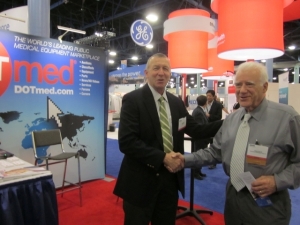
DOTmed's Ron Minor
with a guest at our
SNM 2012 booth.
I came back yesterday from an enjoyable two-day trip to SNM's 2012 annual meeting in Miami Beach, Fla., which started Saturday and ends today.
There's always a lot of energy at good trade shows, but this one had the most energy of all the shows I've been to recently.
You might have noticed that SNM has a new name: it's now the Society of Nuclear Medicine and Molecular Imaging. The field is expanding.
One topic that a lot of people were interested in was amyloid imaging, which has the potential to become a big thing for the industry.
In April, as many of you know, Amyvid, an Eli Lilly drug, became
the first PET imaging agent approved by the FDA to help doctors measure beta-amyloid deposits in the brains of living patients. The deposits are associated with the development of Alzheimer's disease.
While not everyone is convinced, PET amyloid scans might help doctors better manage the disease, either by helping them rule out the presence of Alzheimer's in their patients or by assisting researchers in developing new therapies.
Although Amyvid is the first, it probably won't be the last PET amyloid agent to hit the market. At SNM this year, evidence was shared on several rival agents, including GE Healthcare's Flutemetamol 18F and Piramal Imaging's florbetaben.
Loren Bonner, a DOTmed News reporter who attended the show, has
a story on these developments. I hope you have a chance to read it.
On a personal note, I was disappointed I didn't get a chance to see my old friend Wayne Webster, who broke his knee. An SNM meeting without Wayne is like a peanut butter and jelly sandwich without the peanut butter.
Read more Jacobus Report entries here.
Phil is a member of AHRA, HFMA, AAMI and the Cryogenic Society of America. He has contributed to a number of magazines and journals and has addressed trade groups.
Phil's proudest achievement is that he has been happily married to his wife Barbara since 1989, who helped him found DOTmed in 1998.


Wayne Webster
My wounded knee
June 21, 2012 09:38
Thank you for your kind words about by injury. I too was disappointed to miss the meeting. Unfortunately my injury occurred arriving at the Fontainebleau Hotel. It seems that some genius decided it would be a good idea to have rough surfaces rather than smooth in the driveway for people to drag their bags across. This led to a fall and a broken, or rather shattered knee, a flight home and surgery.
As I write this note I am situated with my leg elevated and suitably strapped in an immobilizing brace from thigh to ankle. Luckily we live in the 21st Century and as long as there is electricity I can communicate from my perch by way of wireless Internet and cell phone. I guess that's a good thing.
But enough about me. I was intrigued by your comments about the SNMMI meeting. I've already left my thoughts about the name change on another SNM blog, seems like window dressing to me and not much more.
What was the SNMMI excitement about? If it was the new radiopharmaceutical for the diagnosis of Alzheimer's disease let me give you a few statistics:
80% of those affected are elderly.
It takes many years for symptoms to appear and when they do it is because the brain can't compensate any longer for the many years of damage caused by the disease. When symptoms appear and the disease is discovered there is no cure.
When cardiology transitioned to myocardial perfusion imaging there was a cure for the disease in many cases. Once finding the cause of the flow defect there was CABG, angioplasty and eventually stents. In addition the doctor could alter diet and life style and frequently cause a positive outcome.
In the case of Alzheimer's dead is dead. Once the cells are damaged there is no fixing them.
>80% cases of dementia are eventually diagnosed as Alzheimer's.
The only way this new area becomes significant for SNMMI or for neurologists is if there is a mass screening of the entire population (unlikely) or if there is a cure (maybe impossible). This leaves us with the group genetically predisposed to the disease. To understand their impact on the SNMMI one need look no further than the breast cancer population and those predisposed to contract breast cancer. This group has little effect on the incidence of breast cancer in the general population or the impact of imaging in the diagnostic imaging arena.
I think the result of the name change and the introduction of a diagnostic radiopharmaceutical is about the same. Everything stays status quo.
to rate and post a comment